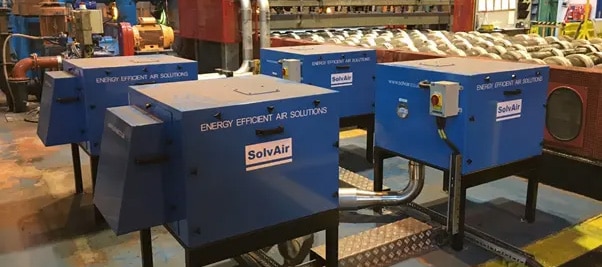Drying system for mobile antenna parts after rinsing process
Electronic Components Manufacturing
Ceramic Tile Production
Used compressed air supply and curtain transvectors. High energy costs and compressed air contains oil which stains the tiles.
We worked with a client whose operations were suffering as a result of ineffective water removal, high levels of noise and high levels of energy usage on their production line.

Our client’s facility used a HHT solution treatment furnace with a quench zone. The purpose of the quench zone was to bring the production plate down to ambient temperature, as well as giving the product its desired properties.
To prevent corrosion (oxidisation) of the product, the plate must be free of all process water on both top and bottom surfaces. The top surface should also be free of all process water to enable removal from the process line via vacuum lifting beam, suspended from a crane.
However, they were experiencing three significant problems; namely that noise levels within the operator area were in excess of 100 dbA creating a Health & Safety risk, their facility was experiencing high power consumption (total 130 kW), and their quench zone was generating a sub-standard performance for them.
The client had had to put operators in place to manually remove water from the top surface of the aluminium plate using squeegee bars, as the existing drying system was ineffectively removing moisture. All adding significant time to the overall process.
Initially, SolvAir made a site visit to the client, bringing demo equipment to make some initial small-scale trials. This meant we were successfully able to assess the requirements of the system, and where it could be improved.
We determined our solution should include two Air Knives situated on top of the plates, and two Air Knives situated below blowing up onto the underside. We designed the system so that the bottom Air Knives were in a fixed position, however the top Air Knives were mounted in a way which allowed their height to be adjusted, based on the plate thickness.
We installed the Air Knives, each 3800mm long, perpendicular to the aluminium sheet. Due to the total length and the level of performance required by each Air Knife, we included one AT1200 15kW High Speed Centrifugal blower per Air Knife. The total system therefore consisted of four AT1200 15kW blowers giving a combined energy requirement of 60kW – resulting in much lower energy usage than the client’s previous solution for water removal, with a huge 54% reduction in power usage costs.
Our system effectively removed water from the plates, requiring no downtime for additional drying, and without disruption to the production line process.
Our client’s CAPEX application for the new system had prioritised the Health & Safety issue, due to the high noise levels of the existing system. Their in-house health & Safety Officer, along with their engineering team, set a maximum limit for their new system at 83dbA. Achieving this would remove the requirement for mandatory ear protection in the wider surrounding work areas. Upon completion of the system, their Health & Safety Officer conducted extensive sound level tests, and the recordings met their requirements as sub 83dbA.
The energy performance of the new system also backed up the client’s investment. Installed energy was reduced by 54% from 130kW down to 60kW. Each blower was controlled by a frequency inverter which during setup were set at only 85% of the available power further reducing the energy consumed by the installation.
No less important was the actual performance of the system in terms of drying effectiveness. Manual operator intervention was eliminated as the Air Knives removed water from the both top and bottom faces of the aluminium plates.
Since its installation, the system has continued to meet the client’s requirements for moisture removal, noise limits and energy usage. As well as this, the system is low maintenance, meaning that it continues to perform highly with a single annual service visit to replace air filters and drive belts.